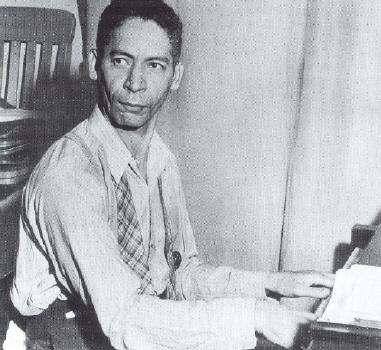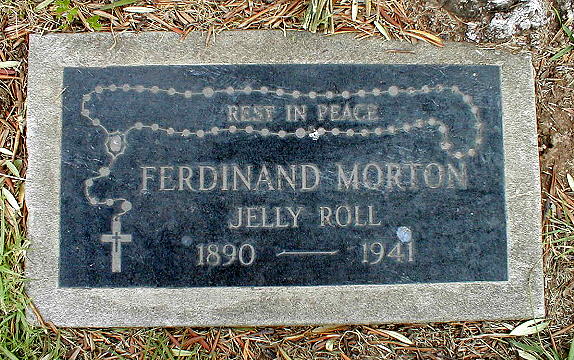Jelly Roll Morton (1885-1941)
Ferdinand "Jelly Roll" Morton was born in 1890 in New Orleans. Or maybe, in 1885; he later claimed to have invented jazz in 1902, which would be more plausible if he had been born in 1885. Although his gravestone shows 1890, three Chicago Tribune reporters in 1999 say that his letters and other documents support the 1885 date (see link above). There is some justification for the claim that he invented jazz: His Jelly Roll Blues (1915) is considered the first published piece of jazz music. This was two years before James P. Johnson pioneered stride piano. (Pianists who have attempted to play Jelly Roll Blues may appreciate the commentary by Richard Trythall.) Why, if Morton invented jazz in 1902, did he wait until 1915 to publish Jelly Roll Blues? Here's what the Chicago Tribune reporters (see link above) wrote about that: Though Morton was a walking encyclopedia of jazz tunes, he never sold them as sheet music because --like most of the old-time piano professors -- he was terrified of publication. Morton came of age when hot piano players from New Orleans to Chicago made their money dazzling listeners with the originality of their riffs and the novelty of their keyboard tricks. Morton, for instance, could make the piano roar like a lion by rolling his left forearm across the low end of the keyboard, as he did in "Tiger Rag." Jelly Roll Morton had some classical piano training, one reads, but apparently the names of his teachers are lost. His father (who abandoned him) and his stepfather were both trombonists. He couldn't have had much classical training, because he was a poor sight reader, and allegedly didn't have a "first rate technique". (I wonder who would dare to say that! but it is repeated here and there without attribution.) Somehow, though, he learned to play jazz, ragtime, and the blues in his teens--after all, he lived in New Orleans, the birthplace of jazz--even though I can find no record of who his teachers were. He left New Orleans in his late teens, lived briefly in Los Angeles, and at age 33 (in 1923) moved to Chicago, where he came into his prime as composer, pianist, band leader, and recording artist. He recorded a historic series of interviews with Alan Lomax at the Library of Congress, and lived for a while in New York. In the 20s in Chicago, Jelly Roll published a number of hits with Melrose Publishing, and hit the peak of success, as the Chicago Tribune article describes vividly: On the road across the Midwest in the '20s, Morton and His Red Hot Peppers (a changing lineup of half a dozen musicians) averaged a then-staggering $1,500 a night. The band traveled in high style in the Morton tour bus, the leader in his own roomy Lincoln. The success showed on every inch of Morton. He gilded himself with diamonds literally from head to toe. They glimmered on his fingers, tie-pin, watch, belt buckle, sock supporters and even on a front tooth, the unlikely setting for a half-carat rock. But from there it was downhill. He moved to New York in 1930, but didn't meet with success there, and "Morton no longer had a band to play his music, a record company to document it or an audience to listen to it. The gaudy showman who owned two luxury cars and more than 100 suits in Roaring '20s Chicago was reduced to hocking his clothes for food in 1930s New York." (Presumably the diamonds had already been hocked!) Jazz had moved on: Duke Ellington and Cab Calloway were kings, and "the only job Morton could get in Manhattan was leading the house band at the Rose Danceland, where women dirty-danced with paying customers, 10 cents a turn." RCA bought Victor Records and canceled Morton's recording contract. The Chicago Tribune article documents how Melrose (his Chicago publisher) cheated Morton by writing unused and unapproved "lyrics" to Morton's compositions and listing himself as "lyricist" on the copyright, then paying himself royalties. Scandalous and reprehensible though it is, that doesn't account for Morton's downfall--musical fashion had just moved on. After five years of failure, Morton moved to Washington, D.C., where he tried to make money as a fight promoter. That went nowhere, and he kept alive by playing piano in a saloon. It must have been a rough saloon since one night he was stabbed by a patron. That may have been the final straw--he moved back to New York, where he started his own music publishing company. Fashion had changed again, this time in Morton's favor, as there was a revival of interest in New Orleans jazz, and he performed solo in 1939. Then fate struck: he was hospitalized with a heart attack. In 1940, in declining health, he moved to Los Angeles, apparently hoping to inherit some diamonds from his godmother (who was she?). That didn't happen, but he formed a new music company and "led a new group of musicians", although he was too sick to perform, and on July 10, 1941, he died of heart disease.
|
Michael Beeson's Home Page
-->

